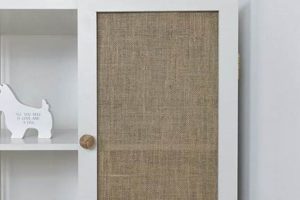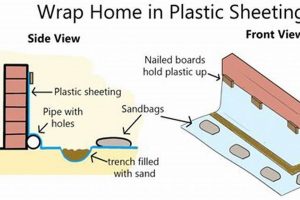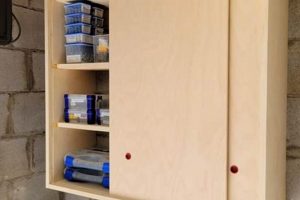The term refers to the process of independently installing decorative trim around door frames. This encompasses a variety of materials and styles, from simple, clean lines to more ornate, traditional designs, all executed by the homeowner or end-user rather than a professional carpenter.
Undertaking this type of project offers numerous advantages. It provides a cost-effective means of enhancing a room’s aesthetic appeal, allowing for personalization and customization beyond what standard builder-grade options offer. Historically, decorative trim served as a marker of status and craftsmanship; today, it represents an opportunity to add character and value to a property. Successfully completing this endeavor can also foster a sense of accomplishment and build practical skills.
Subsequent discussion will focus on essential tools and materials, common design choices, step-by-step installation techniques, and troubleshooting tips for achieving professional-looking results. Emphasis will be placed on precision and attention to detail to ensure a finished product that complements the overall design of the space.
Installation Tips
Achieving a professional finish requires careful planning and precise execution. The following tips provide guidance on key aspects of the process.
Tip 1: Accurate Measurement is Paramount. Before commencing any cutting, measure the door frame meticulously. Double-check all dimensions to avoid costly errors and material wastage. Note any inconsistencies in wall squareness, and adjust cuts accordingly.
Tip 2: Select the Appropriate Material. Consider the style of the room and the desired level of durability. Options range from MDF (Medium-Density Fiberboard) for its affordability and ease of painting, to solid wood for its strength and classic aesthetic.
Tip 3: Utilize the Correct Cutting Tools. A miter saw is essential for achieving accurate angled cuts. Invest in a high-quality blade designed for fine cuts to minimize splintering, particularly when working with hardwoods.
Tip 4: Ensure Proper Adhesion. Apply construction adhesive liberally to the back of each piece before securing it with finishing nails. This provides a strong, long-lasting bond that will prevent separation over time.
Tip 5: Mitering Corners Precisely. Corner joints are critical to the overall appearance. Use a miter saw to create accurate 45-degree angles. Minor imperfections can be filled with wood filler and sanded smooth before painting.
Tip 6: Consistent Nail Placement. Use a nail gun with adjustable depth settings to ensure nails are driven flush with the surface without damaging the trim. Space nails evenly for a professional appearance.
Tip 7: Priming and Painting for a Flawless Finish. Apply a primer coat to seal the material and provide a uniform surface for paint adhesion. Use high-quality paint and apply multiple thin coats, allowing each coat to dry completely before applying the next.
Adherence to these guidelines will contribute to a successful installation, resulting in enhanced visual appeal and long-term durability.
With the above tips in mind, the subsequent steps will detail common errors and resolution for door moulding process.
1. Material Selection
Material selection exerts a profound influence on the success and longevity of a door trim installation project. The choice of material dictates not only the aesthetic character of the trim but also its resistance to moisture, susceptibility to damage, and overall lifespan. A misguided selection can result in premature failure, requiring costly repairs or complete replacement. For instance, installing unprimed MDF in a high-humidity environment can lead to swelling and warping, ultimately compromising the trim’s integrity. Conversely, choosing a durable hardwood, such as oak or maple, in a high-traffic area provides superior impact resistance and minimizes the likelihood of dents and scratches. Thus, careful material consideration is a critical component of the overall process.
Consider, for example, a homeowner seeking to replicate the intricate detailing of Victorian-era trim. While solid wood offers the most authentic appearance, its expense and the complexity of working with it might prove prohibitive. As an alternative, a high-density polyurethane trim can closely mimic the look of wood at a fraction of the cost, and is also lighter and easier to cut and install. This exemplifies the trade-offs often involved in material selection, where budget, skill level, and desired aesthetic must be carefully balanced. Furthermore, primed finger-jointed pine represents a middle ground, offering a stable and paintable surface at a moderate price point, making it a popular choice for many projects.
In summary, material selection is not merely a cosmetic decision but a foundational aspect of any door trim installation endeavor. Understanding the properties, costs, and limitations of various materials is essential for achieving durable, aesthetically pleasing, and cost-effective results. Neglecting this critical step can lead to complications and diminished returns on time and resources invested. The interconnectedness of material choice with the overall success of the project underscores the importance of informed decision-making in this process.
2. Precise Measurements
In the context of independent door trim installation, accurate measurement is not merely a preliminary step; it is the foundational bedrock upon which the success of the entire endeavor rests. Without precise dimensions, the project is predisposed to misalignment, wasted materials, and an ultimately unsatisfactory aesthetic outcome. The integration of accurate measurement is therefore paramount.
- Mitigation of Material Waste
Inaccurate measurements invariably lead to incorrect cuts. These errors necessitate the purchase of additional material to rectify the discrepancies. Precise measurements, on the other hand, minimize waste by ensuring each cut is accurate from the outset, leading to considerable cost savings, especially in larger projects or when utilizing expensive materials such as hardwood.
- Ensuring Proper Fit and Alignment
Door frames are rarely perfectly square. Relying on assumed dimensions rather than actual measurements can result in gaps, overlaps, and an overall unprofessional appearance. Precise measurements, accounting for any irregularities in the frame, enable the creation of trim pieces that fit snugly and align correctly, creating a seamless and visually appealing finished product.
- Facilitation of Consistent Detailing
Many trim styles incorporate repeated patterns or specific proportions. Inaccurate measurements disrupt the consistency of these details, leading to a disjointed and amateurish aesthetic. By adhering to precise measurements, one ensures that each piece of trim maintains the intended dimensions and proportions, contributing to a cohesive and refined visual result.
- Enhancement of Structural Integrity
Beyond aesthetics, precise measurements contribute to the structural integrity of the installation. Ill-fitting pieces can place undue stress on joints, potentially leading to premature failure or separation. Accurate cuts ensure that the trim pieces fit together properly, distributing weight evenly and reinforcing the door frame, enhancing its overall stability.
The cumulative effect of precise measurements is a significant elevation in the quality and longevity of the finished installation. This seemingly simple step, when executed meticulously, transforms a potentially frustrating and costly undertaking into a satisfying and aesthetically pleasing enhancement to the home. Ignoring the imperative of accurate measurement is, therefore, a false economy that undermines the potential for a successful outcome.
3. Miter Saw Accuracy
The correlation between miter saw accuracy and successful independent door trim installation is demonstrably direct and consequential. Inaccurate cuts stemming from a poorly calibrated or improperly used miter saw will manifest as visible gaps, misaligned corners, and an overall substandard finish. This degrades the aesthetic value of the trim and undermines the effort invested in the project. For instance, a 1-degree error in a 45-degree miter cut results in a noticeable gap at the joint, requiring filling and potentially detracting from the intended visual appeal. Therefore, precise angular cuts achieved through a well-maintained and accurately operated miter saw are paramount for achieving professional-looking results.
Miter saw accuracy also affects material usage and project efficiency. Inaccurate cuts lead to wasted material as incorrectly sized pieces become unusable. Repeated errors compound material waste and increase project costs. Consider a scenario where multiple pieces of trim are cut with the same inaccurate angle: the cumulative effect results in a substantial loss of material and necessitates purchasing additional supplies. Accurate miter saw operation, facilitated by proper setup, blade selection, and technique, minimizes waste and allows for efficient project completion. Furthermore, using jigs and stops, guided by precise measurements, contributes to repeatable accuracy, especially when cutting multiple identical pieces.
In summary, miter saw accuracy is an indispensable element of successful independent door trim installation. The effects of inaccuracy range from cosmetic imperfections to significant material waste and increased project costs. Prioritizing proper miter saw calibration, blade selection, and cutting technique is essential for achieving professional results, maximizing material usage, and ensuring efficient project completion. The quality of the finished trim is directly proportional to the precision afforded by the miter saw.
4. Adhesive Application
The effective utilization of adhesive is a crucial component within the broader context of independent door trim installation. It serves not merely as a supplementary measure but as a foundational element contributing to the long-term stability and aesthetic integrity of the installed trim. Proper adhesive application ensures robust adhesion to both the door frame and the trim itself, mitigating the risk of separation or movement over time.
- Surface Bonding Enhancement
Adhesive application significantly increases the bonding surface area between the trim and the door frame. While fasteners such as nails or screws provide localized holding power, adhesive creates a continuous bond across the entire contact surface. This is particularly important when working with uneven surfaces or materials with varying expansion and contraction rates. A real-world example is the use of construction adhesive when attaching trim to painted surfaces, where the adhesive helps to overcome the reduced adhesion of fasteners on a slick surface.
- Vibration and Impact Resistance
Door frames are subject to repeated vibrations from door openings and closings, as well as potential impacts from furniture or foot traffic. Adhesive acts as a dampening agent, absorbing some of these vibrations and minimizing the stress on fasteners. This is particularly relevant in high-traffic areas or in homes with active families. Without adhesive, fasteners alone may loosen over time due to vibration, leading to visible gaps and compromised structural integrity.
- Gap Filling and Imperfection Compensation
Door frames are rarely perfectly uniform or square. Minor gaps or imperfections can exist between the frame and the trim. Adhesive effectively fills these gaps, creating a seamless appearance and preventing the ingress of moisture or insects. The use of a high-viscosity construction adhesive is particularly beneficial in these situations, as it can bridge larger gaps and provide a level surface for subsequent painting or finishing.
- Long-Term Stability and Prevention of Movement
The combination of adhesive and fasteners provides a synergistic effect, ensuring long-term stability and preventing trim movement. Adhesive acts as a permanent bonding agent, while fasteners provide initial holding power during the curing process. This combination minimizes the risk of trim separation or shifting over time, even under conditions of temperature fluctuations or humidity changes. The use of a quality construction adhesive, specifically formulated for bonding wood or synthetic trim materials, contributes significantly to the longevity of the installation.
In conclusion, the judicious and proper application of adhesive is indispensable for achieving a durable, aesthetically pleasing, and structurally sound door trim installation. It is not a mere afterthought but a fundamental component that contributes to the long-term performance and visual appeal of the finished project. The omission or improper execution of adhesive application can compromise the entire installation, leading to premature failure and diminished aesthetic returns.
5. Nail Gun Control
The successful execution of independent door trim installation is inextricably linked to proficient nail gun control. A nail gun, while efficient for securing trim pieces, can be detrimental to the final result if mishandled. Improper depth settings, inconsistent pressure, and incorrect nail placement lead to visible nail holes, split trim, or inadequate fastening. The effects of uncontrolled nail gun usage necessitate extensive filling, sanding, and potential replacement of damaged trim, increasing project time and material costs. Conversely, deliberate nail gun operation, accounting for material density and trim thickness, ensures a secure, aesthetically pleasing, and structurally sound installation.
Effective nail gun control extends beyond merely setting the appropriate depth. Understanding the wood’s grain, particularly in hardwoods, is crucial to prevent splitting. Nailing too close to the edge of the trim can also induce fractures. Careful consideration of nail placement, spacing, and angle optimizes holding power while minimizing cosmetic damage. For example, when attaching delicate trim, such as quarter-round, employing a brad nailer with a narrower gauge and lower pressure minimizes the risk of splitting the thin wood. Further, utilizing a consistent nailing pattern contributes to uniform stress distribution, preventing warping or detachment over time.
In summation, nail gun control is an indispensable component of independent door trim installation. Its mastery yields a professional-looking result, minimizes material waste, and ensures the long-term stability of the installed trim. Recognizing the potential pitfalls of uncontrolled nail gun use and implementing best practices for depth adjustment, nail placement, and pressure management significantly enhances the likelihood of a successful and visually appealing finished product.
6. Surface Preparation
In the context of independent door trim installation, surface preparation transcends mere preliminary activity; it constitutes a foundational phase that directly influences the adhesion, longevity, and aesthetic appeal of the final product. Proper surface preparation provides a clean, stable substrate conducive to optimal trim adhesion and finish application. Neglecting this critical step invariably compromises the quality and durability of the entire installation.
- Removal of Existing Obstructions
The presence of old trim, caulk, nails, or paint imperfections impede proper trim alignment and adhesion. Failure to remove these obstructions results in uneven surfaces, creating gaps between the new trim and the door frame. For example, remnants of old caulk can prevent the trim from sitting flush against the wall, leading to unsightly gaps that require filling and potentially impacting the structural integrity of the installation. Rigorous removal of all existing obstructions is therefore essential for creating a uniform and receptive surface.
- Cleaning and Degreasing
Accumulated dirt, dust, grease, or fingerprints compromise the adhesion of both adhesives and paint. These contaminants create a barrier between the surface and the bonding agent, leading to premature peeling or blistering. Consider a scenario where trim is installed on a door frame in a kitchen; grease splatters, if not thoroughly removed, prevent the adhesive from forming a strong bond. Cleaning with a suitable degreasing agent ensures a clean, receptive surface, promoting optimal adhesion and a long-lasting finish.
- Sanding and Priming
Sanding smooths rough surfaces, improves adhesion, and creates a consistent texture for paint or stain application. Priming seals porous materials, providing a uniform base for subsequent coats and enhancing the durability of the finish. For example, installing trim on unfinished wood without sanding creates a rough texture that detracts from the aesthetic appeal. Similarly, failing to prime porous MDF can result in uneven paint absorption, leading to a blotchy finish. Proper sanding and priming are therefore crucial for achieving a professional-looking and durable result.
- Addressing Moisture Content
High moisture content in either the door frame or the trim can lead to dimensional instability, causing warping, cracking, or paint failure. Installing trim on a damp surface traps moisture, creating an environment conducive to mold growth and wood rot. Ensuring that both the door frame and the trim are sufficiently dry before installation minimizes the risk of these issues. This can be achieved through acclimatization and, if necessary, the use of a dehumidifier to reduce ambient humidity levels prior to installation.
Collectively, these aspects of surface preparation contribute to a superior finished product in independent door trim installation. The time invested in meticulous surface preparation is recouped through improved adhesion, enhanced durability, and an aesthetically pleasing outcome. Neglecting this critical phase invariably results in compromised quality and necessitates costly repairs or replacements, underscoring the importance of thorough surface preparation.
7. Paint Finish
The ultimate aesthetic success of independently installed door trim is inextricably linked to the quality and execution of the paint finish. The paint finish serves as the visual culmination of the entire project, either enhancing meticulously executed trim work or highlighting flaws arising from inadequate preparation or application.
- Surface Sealing and Protection
Paint acts as a protective barrier, sealing the trim material against moisture intrusion, UV degradation, and physical damage. Proper paint application, including priming, prevents water absorption in porous materials like MDF or pine, mitigating warping, swelling, or rot. A durable paint finish also protects against scratches, dents, and general wear and tear, extending the lifespan of the trim installation. For example, a high-gloss enamel paint is often used in high-traffic areas due to its increased durability and ease of cleaning.
- Aesthetic Enhancement and Style Integration
Paint color, sheen, and application technique dramatically influence the overall aesthetic and ability to harmonize with a room’s existing decor. A carefully chosen paint color complements the wall color, flooring, and furniture, creating a cohesive and visually appealing space. The paint finish also contributes to the perceived style, ranging from the sleek, modern look of a semi-gloss finish to the traditional, understated elegance of a matte finish. Incorrect color selection or uneven paint application detracts from the intended aesthetic.
- Concealment of Imperfections and Mitigation of Visual Defects
Paint effectively conceals minor imperfections, such as nail holes, filled joints, and slight surface irregularities. Primer fills small voids and provides a uniform surface for paint adhesion, minimizing the visibility of these defects. Skilled paint application techniques, such as feathering and proper brush or roller control, further minimize visual imperfections. Conversely, a poorly applied paint finish accentuates flaws and undermines the overall quality of the installation.
- Durability and Maintainability
The type and quality of paint directly impact the durability and ease of maintaining the door trim. High-quality paints resist fading, cracking, and chipping, requiring less frequent repainting. Certain paint formulations are specifically designed for easy cleaning, allowing for removal of dirt, smudges, and stains without damaging the finish. Utilizing a durable, washable paint prolongs the life of the paint finish and reduces maintenance demands. Interior latex paints are a common choice because of their low VOC content and relative ease of application and cleanup.
In conclusion, the paint finish is not merely a superficial layer but an integral component of successful independently installed door trim. It provides surface protection, aesthetic enhancement, imperfection concealment, and contributes to the long-term durability and maintainability of the installation. Therefore, meticulous attention to paint selection, preparation, and application is essential for achieving a professional-looking and long-lasting result.
Frequently Asked Questions
The following questions address common inquiries regarding independent door trim installation. Each response aims to provide concise and informative guidance.
Question 1: What tools are absolutely essential for achieving a professional result?
A miter saw with a sharp blade is non-negotiable for accurate angled cuts. A nail gun significantly expedites the attachment process, but must be used with controlled depth settings. A level, measuring tape, and combination square are crucial for precise measurements and alignment. Caulk and a caulking gun are needed for sealing gaps. Sandpaper, wood filler, and paint supplies ensure a smooth, finished surface.
Question 2: How can splitting of the trim material during nailing be prevented?
Pre-drilling pilot holes, particularly when working with hardwoods, mitigates the risk of splitting. Employing a brad nailer with a smaller gauge also minimizes the likelihood of damage. Avoid nailing too close to the edge of the trim. Adjust the nail gun’s depth setting to prevent over-driving the nails.
Question 3: What type of adhesive is best suited for door trim installation?
Construction adhesive formulated for bonding wood and other building materials provides a strong and durable bond. Choose an adhesive with a low VOC (Volatile Organic Compound) content to minimize off-gassing. Ensure the adhesive is compatible with the trim material and the door frame’s surface. Follow the manufacturer’s instructions for application and curing times.
Question 4: How is proper alignment ensured when attaching the trim?
Utilize a level to verify that each piece of trim is vertically or horizontally aligned. Use shims to correct any minor imperfections in the door frame. Before securing each piece permanently, dry-fit it to ensure proper placement and alignment. Mark the position of the trim on the door frame as a reference point.
Question 5: What is the recommended method for filling nail holes and seams?
Use wood filler that is paintable and sandable. Apply the filler sparingly, using a putty knife to press it firmly into the holes or seams. Allow the filler to dry completely before sanding it smooth. Avoid over-sanding, which can damage the surrounding trim surface. Prime the filled areas before painting.
Question 6: How is a professional-looking paint finish achieved?
Apply a primer coat to seal the trim and provide a uniform surface for paint adhesion. Use high-quality paint formulated for interior trim. Apply multiple thin coats, allowing each coat to dry completely before applying the next. Use a high-quality brush or roller designed for smooth finishes. Sand lightly between coats to remove any imperfections. Consider using a paint sprayer for a flawless finish on intricate designs, but only with adequate ventilation and safety precautions.
Achieving satisfactory results in independent door trim installation hinges on the proper application of tools, materials, and techniques. Careful adherence to established best practices is highly recommended.
The subsequent section will address common mistakes.
DIY Door Moulding
This exploration of independent door trim installation has underscored the importance of precision, material selection, and adherence to established techniques. From accurate measurement and miter saw operation to appropriate adhesive application, controlled nail gun usage, surface preparation, and meticulous paint finishing, each stage significantly impacts the overall quality and longevity of the finished product. Mastery of these aspects is paramount for achieving professional-looking results and maximizing the investment of time and resources.
The successful completion of decorative trim projects relies on a commitment to detail and a thorough understanding of best practices. While seemingly straightforward, effective execution requires careful planning, skillful application, and a dedication to continuous improvement. The lasting visual impact of well-executed decorative trim underscores its significance as a valuable enhancement to interior spaces.







